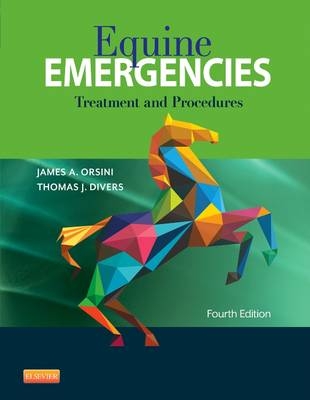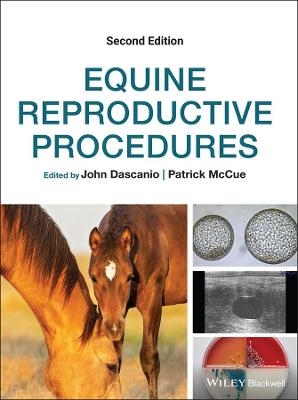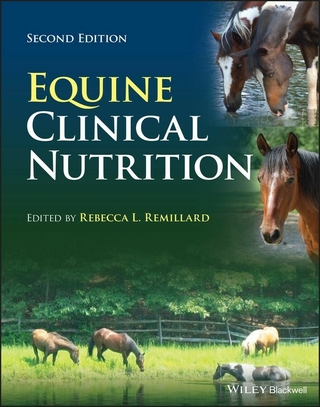
Equine Emergencies
Saunders (Verlag)
978-1-4557-0892-5 (ISBN)
Ideal for use in the clinic and in the field, Equine Emergencies: Treatment and Procedures, 4th Edition , offers practical step-by-step guidelines for effectively managing a wide range of emergency situations. Thoroughly updated content keeps you informed of the latest advances in horse care in a portable, convenient format.
Respond quickly and confidently to emergency situations with the only text dedicated entirely to equine emergency treatment. The latest edition of this reliable manual is vastly expanded to encompass a wide range of new and evolving topics in horse care, with thorough, step-by-step procedures for the most effective emergency treatment. Portable for use in the clinic or in the field and presented for the first time in full color, it's your one-source guide for complete equine emergency support.
James A. Orsini is an Associate Professor of Surgery at the University of Pennsylvania and has been a faculty member for more than 35 years. Dr. Orsini teaches in multiple disciplines, including both basic and clinical courses throughout the professional curriculum. He has co-edited four editions of Equine Emergencies - an Elsevier book and one of the health sciences' best-selling equine publications. In addition, he has authored several hundred papers, book chapters, abstracts and proceedings. Dr. Divers is a diplomate of both the American College of Veterinary Internal Medicine and American College of Veterinary Emergency and Critical Care. His equine interest are in any medical diseases of the horse and research projects have centered around neurologic and liver diseases of horses, critical care medicine, in addition to several infectious diseases.
PART 1: EMERGENCY PROCEDURES AND DIAGNOSTICS
Section I: Important Diagnostic and Therapeutic Procedures for Emergency Care
1. Blood Collection
2. Medication Administration and Alternative Methods of Drug Administration
3. Intravenous Catheter Selection, Sites for Placement and Maintenance
4. Venous Cutdown
5. Intraosseous and Regional Perfusion
6. Biopsy Techniques
7. Hyperbaric Oxygen Indications in Emergencies
8. Alternative Therapies in Emergencies: Acupuncture
Section II: Emergency Imaging, Endoscopy, Laboratory Diagnostics and Monitoring
9. Bacterial, Fungal and Viral Diagnostic Samples
10. Critical and Emergency Care Monitoring Techniques
11. Cytology
12. Emergency Diagnostic Endoscopy
13. Gene Testing
14. Imaging Techniques and Indications for the Emergency Patient
15. Laboratory Tests and Point of Care Diagnostics
PART 2: EMERGENCY EXAMINATION AND MANAGEMENT OF ORGAN SYSTEMS
Section I: Body and Organ Systems
16. Blood Coagulation Disorders
17. Cardiovascular System
18. Gastrointestinal System
19. Integumentary System
20. Liver Failure, Anemia and Blood Transfusion
21. Musculoskeletal System
22. Nervous System
23. Ophthalmology
24. Reproduction System
25. Respiratory System
26. Urinary System
Section II: Pregnancy, Perinatal/Neonatal Period
27. Monitoring the Pregnant Mare
28. Emergency Foaling
29. Foal Resuscitation
30. Perinatology
31. Neonatology
Section III: Shock, Temperature Related Problems, Systemic Inflammatory Response Syndrome and Muti-Organ Dysfunction Syndrome
32. Shock, Systemic Inflammatory Response Syndrome (SIRS), Multi-Organ Dysfunction Syndrome (MODS)
33. Temperature Related Problems: Hypothermia and Hyperthermia
PART 3: TOXICOLOGY
34. Toxicology
PART 4: SPECIAL PROBLEM EMERGENCIES
Section I: Special Problems
35. Burns, Acute Soft Tissue Swellings. Pigeon Fever
36. Caring for the Down Horse
37. Disaster Medicine
38. Diseases Unique to Donkeys and Miniature Horses
39. Diseases Unique to Draft Horses
40. Emergency Diseases Unique to Countries Outside the Continental United States
41. Flood Injury
42. Foot Injuries
43. Laminitis
44. Orthopedic Emergencies of the Racing Athlete
45. Snake Envenomination
46. Thoracic Trauma
Section II: Anesthesia
47. Anesthesia for Out-of-Hospital Emergencies
48. Euthanasia/Humane Destruction
49. Pain Management
Section III: Nutrition
50. Approach to the Feed and Starvation Emergency
51. Nutritional Guidelines for the Injured, Hospitalized and Postsurgical Patient
Section IV: Biosecurity
52. Contagious and Zoonotic Diseases
53. Standard Precautions and Infectious Disease Management
APPENDICES
1: Commonly Used Formulas and Calculations in Emergency Care
2: Important Equivalents and Conversions for Clinical Practice
3: Miscellaneous Charts and Tables Useful in Clinical Practice
4: Reference Values
5: Clinical Pharmacology and Emergency Drug Facts
A. Emergency Drugs, Recommended Dosages and Adverse Drug Events
B. Drugs for Specific Emergencies, Protocols and Clinical Situations
Antibiotics - Concentration Dependent vs. Time Dependent Drugs
Anesthetic Induction
Cardio-Respiratory Resuscitation
Cardiac Arrhythmia Drugs and Protocols
Pharmacologic Adjuncts to Intubation
Physical and Chemical Restraint
Pressors
Prokinetics
Seizure Control
Sepsis
Shock
C. Adverse Drug Events and Management
D. Clinical Signs and Overdose Response of Commonly Used Medications and
Recommended Treatments
INDEX
| Erscheint lt. Verlag | 8.1.2014 |
|---|---|
| Zusatzinfo | Illustrations |
| Verlagsort | Philadelphia |
| Sprache | englisch |
| Maße | 216 x 276 mm |
| Gewicht | 2245 g |
| Einbandart | Paperback |
| Themenwelt | Veterinärmedizin ► Pferd |
| ISBN-10 | 1-4557-0892-5 / 1455708925 |
| ISBN-13 | 978-1-4557-0892-5 / 9781455708925 |
| Zustand | Neuware |
| Haben Sie eine Frage zum Produkt? |
aus dem Bereich



